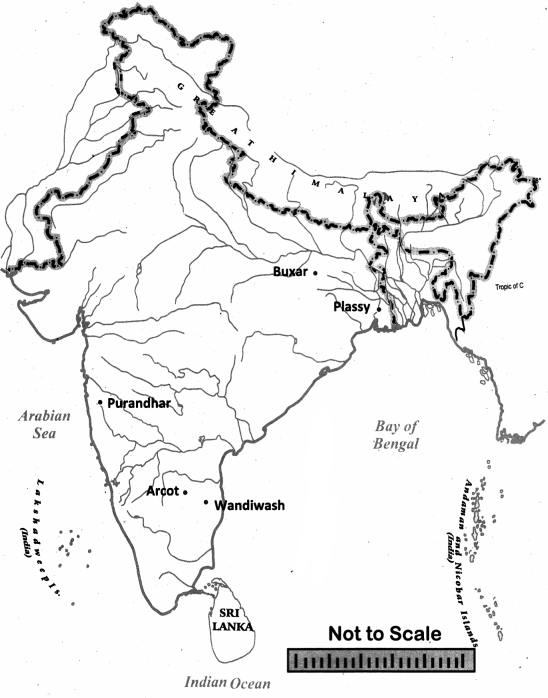8th Social Science – History Book Back
& Questions Answers (solution)
Term 1
2. From Trade to Territory
8th Social Science History Solutions Term 1 – Chapter 2 From Trade to Territory Tamilnadu Samacheer Kalvi – English medium
I. Choose the correct answer
1. The ruler of Bengal in 1757 was ……………
(a) Shuja – ud – daulah
(b) Siraj – ud – daulah
(c) Mirkasim
(d) Tippu Sultan
Answer: (b) Siraj – ud – daulah
2. The Battle of Plassey was fought in ………………
(a) 1757
(b) 1764
(c) 1765
(d) 1775
Answer: (a) 1757
3. Which among the following treaty was signed after Battle of Buxar?
(a) Treaty of Allahabad
(b) Treaty of Carnatic
(c) Treaty of Alinagar
(d) Treaty of Paris
Answer: (a) Treaty of Allahabad
4. The Treaty of Pondichery brought the …………….. Carnatic war to an end .
(a) First
(b) Second
(c) Third
(d) None
Answer: (b) Second
5. When did Hyder Ali crown on the throne of Mysore?
(a) 1756
(b) 1761
(c) 1763
(d) 1764
Answer: (b) 1761
6. Treaty of Mangalore was signed between ……………..
(a) The French and Tippu Sultan
(b) Hyder Ali and Zamorin of Calicut
(c) The British and Tippu Sultan
(d) Tippu Sultan andMarathas
Answer: (c) The British and Tippu Sultan
7. Who was the British Governor General during Third Anglo – Mysore War?
(a) Robert Clive
(b) Warren Hastings
(c) Lord Cornwallis
(d) Lord Wellesley
Answer: (c) Lord Cornwallis
8. Who signed the Treaty of Bassein with the British?
(a) Bajirao II
(b) DaulatraoScindia
(c) SambhajiBhonsle
(d) SayyajiraoGaekwad
Answer: (a) Bajirao II
9. Who was the last Peshwa of Maratha empire?
(a) BalajiVishwanath
(b) BajiRao II
(c) BalajiBajiRao
(d) BajiRao
Answer: (d) BajiRao II
10. Who was the first Indian state to join the subsidiary Alliance?
(a) Oudh
(b) Hyderabad
(c) Udaipur
(d) Gwalior
Answer: (b) Hyderabad
II. Fill in the Blanks
- The Treaty of Alinagar was signed in ……………..
- The commander in Chief of Sirajuddaula was ……………….
- The main cause for the Second Carnatic war was ……………….
- ………………. adopted the policy of Doctrine of Lapse to extend the British Empire in India.
- Tippu Sultan was finally defeated at the hands of ……………….
- After the death of Tippu Sultan Mysore was handed over to ……………….
- In 1800, ………………… established a college at Fort William in Calcutta.
Answer:
- 1757
- Mir Jafar
- The issue of succession
- Lord Dalhousie
- Arthur Wellesely
- Krishna Raja Odayar
- Lord Wellesley
III. Match the following

Answer:
- ii
- iv
- iii
- V
- i.
IV. State true or false
- After the death of Alivardi Khan, Siraj – ud – daula ascended the throne of Bengal.
Answer: True
2. Hector Munro, led the British forces in the battle of Plassey.
Answer: False
Correct statement: Robert Clive, led the British forces in the battle of Plassey.
3. The outbreak of the Austrian war of succession in Europe was led to Second Carnatic War in India.
Answer: False
Correct statement: The outbreak of the Austrian war of succession in Europe was led to First Carnatic War in India.
4.Sir Elijalmpey was the first Chief Justice of the Supreme Court at Fort William in Bengal.
Answer: True
5.The Police system was created by Lord Cornwallis.
Answer: True
V. Which one of the following is correctly matched?
- Battle of Adayar – 1748
- Battle of Ambur – 1754
- Battle of Wandiwash – 1760
- Battle of Arcot – 1749
Answer: 3. Battle of Wandiwash – 1760
VI. Answer the following in one or two sentences
1. Write a short note on Black Hole Tragedy.
Answer:
The Black Hole tragedy (1756)
There was a small dungeon room in the Fort William in Calcutta, where troops of the Nawab of Bengal Siraj – ud – daula, held 146 British Prisoners of war for one night. Next day morning, when the door was opened 123 of the prisoners found dead because of suffocation.
2. What were the benefits derived by the English after the Battle of Plassey?
Answer:
After the Battle of Plassey in 1757, the company was granted undisputed right to have free trade in Bengal, Bihar and Orissa. It received the place of 24 parganas in Bengal.
The beginning of the British political sway over India may be traced from the Battle of Plassey. It was the most decisive battle that marked the initiation of British rule in India for the next two centuries.
3. Mention the causes for the Battle of Buxar.
Answer:
Mir Qasim the son in law of the Nawab of Bengal revolted as he was angry with the British for misusing the destakes (free duty passes).
4. What were the causes for the First Mysore War?
Causes:
Answer:
- Haider Ali’s growing power and his friendly relations with the French became a matter of concern for the English East India Company.
- The Marathas, the Nizam and the English entered into a triple alliance against Haider Ali.
5. Bring out the results of the Third Maratha War.
Answer:
- The Maratha confederacy was dissolved and Peshwaship was abolished.
- Most of the territory of Peshwa BajiRao II was annexed and became part of the Bombay Presidency
- The defeat of the Bhonsle and Holkar also resulted in the acquisition of the Maratha kingdoms of Nagpur and Indore by the British.
- The BajiRao II, the last Peshwa of Maratha was given an annual pension of 8 lakh rupees.
6. Name the states signed into Subsidiary Alliance.
Answer:
The first Indian state to accept the Subsidiary Alliance was Hyderabad (1798). It was followed by Tanjore (1799), Awadh (1801), Peshwa (1802), Bhonsle (1803), Gwalior (1804), Indore (1817), Jaipur, Udaipur and Jodhpur (1818).
VII. Answer the following in detail
1. Write an essay on second Carnatic war.
Answer:
In the 18th century, three Carnatic wars were fought between various Indian rulers, British and French East Indian Company on either side.
Second Carnatic War:
1. The main cause of this war was the issue of succession in Carnatic and Hyderabad. Anwaruddin Khan and Chanda Sahib were the two claimants to the throne of Carnatic, whereas Nasir Jang and Muzaffar Jang were claimants to the throne of Hyderabad.
2. The French supported Chanda sahib and Muzaffar Jang, while the British supported the other claimants with the objective of keeping their interest and influence in the entire Deccan region.
Battle of Ambur (1749):
1. Finally Dupleix, Chanda Sahib and Muzaffar Jang formed a grand alliance and defeated and killed Anwar-ud-din Khan, the Nawab of Carnatic, in the Battle of Ambur.
2. Muhammad Ali, the son of Anwar – ud – din, fled to Trichinopoly.
3. Chanda Sahib became the Nawab of Carnatic and rewarded the French with the grant of 80 villages around Pondicherry.
4. In the Deccan, the French defeated and killed Nasir Jang and made Muzaffar Jang as the Nizam.
5. The new Nizam gave ample rewards to the French.
6. He appointed Dupleix as the governor of all the territories in south of the river Krishna. Muzaffar Jang was assassinated by his own people.
7. Salabat Jang, brother of Nasir Jang was raised to the throne by Bussy.
8. Salabat Jang granted the Northern Circars to the French.
9. Dupleix’s power was at its zenith by that time.
Battle of Arcot (1751):
1. In the meantime, Dupleix sent forces to besiege the fort of Trichy
2. Chanda Sahib also joined with the French in their efforts to besiege Trichy. Robert Clive’s proposal was accepted by the British governor, Saunders, and with only 200 English and 300 Indian soldiers, Clive was entrusted the task of capturing Arcot. His attack proved successful.
3. Robert Clive defeated the French at Ami and Kaveripak. With the assistance of Lawrence, Chanda Sahib was killed in Trichy. Muhammad Ali was made the Nawab of Arcot under British protection. The French Government recalled Dupleix to Paris.
Treaty of Pondicherry (1755):
1. Dupleix was succeeded by Godeheu who agreed the treaty of Pondicherry. According to it, both the powers agreed not to interfere in the internal affairs of the native states. They were to retain their old positions. New forts should not be built by either power. The treaty made the British stronger.
2. The second Carnatic war also proved inconclusive. The English proved their superiority on land by appointing Mohammad Ali as the Nawab of Carnatic. The French were still very powerful in Hyderabad. However, the predominant position of the French in the Deccan peninsula was definitely undermined in this war.
2. Give an account of the Fourth Anglo Mysore war.
Answer:
The Fourth Anglo – Mysore War:
Tipu Sultan did not forget the humiliating treaty of Srirangapatnam imposed upon him by Cornwallis in 1790.
Causes:
- Tipu sought alliance with foreign powers against the English and sent ambassadors to Arabia, Turkey, Afghanistan and the French.
- Tipu was in correspondence with Napoleon who invaded Egypt at that time.
- The French officers came to Srirangapatnam where they founded a Jacobin Club and planted the Tree of Liberty.
Course:
1. Wellesley declared war against Tipu in 1799. The war was short and decisive. As planned, the Bombay army under General Stuart invaded Mysore from the west.
2. The Madras army, which was led by the Governor – General’s brother, Arthur Wellesley, forced Tipu to retreat to his capital Srirangapatnam.
3. On 4th May 1799 Srirangapatnam was captured. Tipu fought bravely and was killed finally. Thus ended the fourth Mysore War and the whole of Mysore lay prostrate before the British.
Mysore after the War:
- The English occupied Kanara, Wynad. Coimbatore. Darapuram and Srirangapattinam.
- Krishna Raja Odayar of the former Hindu royal family was brought to the throne.
- Tipu’s family was sent to the fort of Vellore.
3. Describe the policy adopted by Lord Dalhousie to expand the British empire in India.
Answer:
Doctrine of Lapse:
1. Lord Dalhousie was one of the chief architects of the British Empire in India. He was an imperialist. He adopted a new policy known as Doctrine of Lapse to extend British Empire.
2. He made use of this precedent and declared in 1848 that if the native rulers adopted children without the prior permission of the Company, only the personal properties of the rulers would go to the adopted sons and the kingdoms would go to the British paramount power. This principle was called the Doctrine of Lapse.
3. It was bitterly opposed by the Indians and it was one of the root causes for the great revolt of 1857.
4. How did Lord Wellesley expand the British
Answer:
The Subsidiary Alliance:
- Lord Wellesley introduced the system of Subsidiary Alliance to bring the princely states under the control of the British.
- It was the most effective instrument for the expansion of the British territory and political influence in India.
- The princely state was called ‘the protected state’ and the British came to be referred as ‘the paramount power’.
- It was the duty of the British to safeguard the state from external aggression and to help its ruler in maintaining internal peace.
Main Features of Subsidiary Alliance:
- An Indian ruler entering into this alliance with the British had to dissolve his own armed forces and accept British Forces.
- A British Resident would stay in his capital.
- Towards the maintenance charges of the army, he should make annual payments or cede some territory permanently to the Company.
- All the non – English European officials should be turned out of his state.
- The native ruler should deal with foreign states only through the English Company.
- The British would undertake to defend the state from internal trouble as well as external attack.
VIII. HOTs
1. Explain the causes for the success of the English in India.
Answer:
1. Lack of unity among Indian Stats:
Even though there were powerful kings and who ruled Punjab, Mysore and Maratha region, they lacked unity and fought with each other for various reasons. They failed to perceive the danger arising from the East India Company.
2. Greater Naval Power:
The British came through the sea and established a strong naval power in the Indian Ocean before coming to the Indian main land. There was no strong naval power in India to challenge the Brititsh.
3. Development of textile:
By the beginning of the 19th century English made cotton textiles successfully ousted Indian goods from their traditional markets.
4. Scientific division of labour:
The production and growth of modem science in India was encouraged by the British with a view to further colonial interests.
5. Economic prospertiy:
The British had enough funds to pay its share holders that compelled them to finance the English wars in India.
IX. Mark the following on the River map of India
1.
- Plassy
- Buxar
- Purandhar
- Arcot
- Wandiwash
Answer:

Tags:
8th social guide samacheer kalvi,samacheer kalvi 8th books guide social science,social guide for 8th standard samacheer kalvi,samacheer kalvi guru 8th social guide,8th standard social guide samacheer kalvi,samacheer kalvi 8th social guide pdf,8th social guide tamil medium samacheer kalvi,8th social guide tamil medium samacheer kalvi,samacheer kalvi 8th books guide social science,samacheer kalvi guru 8th social guide,samacheer kalvi 8th social guide pdf,8th standard social guide samacheer kalvi,8th social guide tamil medium samacheer kalvi,8th social guide tamil medium samacheer kalvi,social guide for 8th standard samacheer kalvi,samacheer kalvi 8th books guide social science,samacheer kalvi guru 8th social guide,social guide for 8th standard samacheer kalvi,samacheer kalvi 8th social guide pdf,8th standard social guide samacheer kalvi,samacheer kalvi 8th books guide social science,samacheer kalvi guru 8th social guide,social guide for 8th standard samacheer kalvi,8th social guide tamil medium samacheer kalvi,8th standard social guide samacheer kalvi,8th social guide tamil medium samacheer kalvi,samacheer kalvi 8th social guide pdf,samacheer kalvi 8th books guide social science,social guide for 8th standard samacheer kalvi,samacheer kalvi guru 8th social guide,8th social guide tamil medium samacheer kalvi,8th standard social guide samacheer kalvi,samacheer kalvi 8th social guide pdf,8th social guide tamil medium samacheer kalvi,samacheer kalvi 8th books guide social science,social guide for 8th standard samacheer kalvi,samacheer kalvi guru 8th social guide,8th social guide tamil medium samacheer kalvi,8th social guide tamil medium samacheer kalvi,samacheer kalvi 8th social guide pdf,8th standard social guide samacheer kalvi,samacheer kalvi 8th books guide social science,samacheer kalvi guru 8th social guide,social guide for 8th standard samacheer kalvi,samacheer kalvi 8th social guide pdf,8th standard social guide samacheer kalvi,8th social guide tamil medium samacheer kalvi,samacheer kalvi 8th books guide social science,social guide for 8th standard samacheer kalvi,samacheer kalvi guru 8th social guide,8th social guide tamil medium samacheer kalvi,8th standard social guide samacheer kalvi,samacheer kalvi 8th social guide pdf,8th social guide tamil medium samacheer kalvi,


